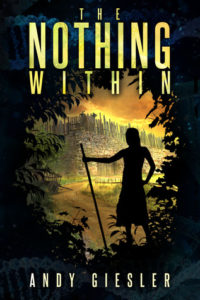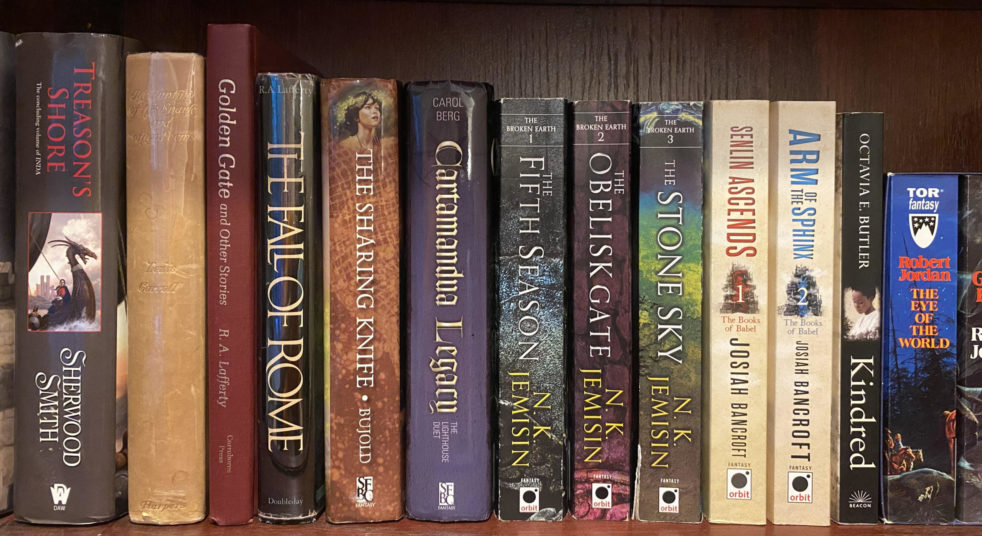
Andy Giesler released his debut during the summer of 2019, but it didn’t hit my radar until it made the semifinals of this year’s Self-Published Fantasy Blog-Off. While it was not chosen as a finalist, I found its review more intriguing than the book chosen out of that semifinal group, so I decided to give it a shot. A few hundred pages later, I found myself wondering how it didn’t pick up more momentum–The Nothing Within is outstanding.
The Nothing Within falls into that weird space between subgenres where it feels like a fantasy story but the reader can see that many of the ostensible fantasy elements are science in disguise. The main story is told by Old Root, a itinerant storyteller, who regales her audience with tales from her life–from age seven to twenty-three, skipping as needed–interspersed with journal entries (also written in first-person) from long ago Ruth Troyer and a handful of folk tales and third-person passages from other side characters. The world, as Root knows it, is thus:
The World That Is is a great circle. Within its circle we have troubles aplenty, but we have weavers to guide us and shepherds to protect us.
Around the edge of the World That Is lies the Void. A void dug by the Wrathful Spirits so very long ago. A void as broad as a great village and filled with churning waters far below.
And beyond the Void is the World That Was. We cannot go to the World That Was. We would not go even if we could. It is the endless village of Gebohra Muerta, who loves us more than she loves herself, and who would destroy us if she could.
What the reader knows, that the first-time listeners among Root’s audience does not know, is that The World That Is contains the only known survivors of a technological apocalypse more than a thousand years prior. An Amish community in north central Ohio, along with a handful of others that they took in, built a community of farmers and craftspeople, with a strict aversion to technology and walled towns to protect against roving chimeras. The reader knows this because Ruth Troyer’s journal entries take place during the 22nd century, right in the thick of the apocalypse. These journal entries give the audience context for Root’s own story of growing up blind and inquisitive in a world uncomfortable with difference and investigation, learning about the Nothing and how it threatens her world.
I found the premise plenty intriguing–you don’t see many rural dystopias–but it was the narration that sold me. The oral storyteller narration style won’t work for everyone, but I found Root’s voice so distinctive and compelling that I was fascinated from the very beginning. It takes a while for the pieces to start to fall into place and for the reader to understand the shape of the conflict in the main storyline, but the quality of Root’s storytelling carries the narrative smoothly through the background of her life and world. Furthermore, the selections from Ruth Troyer’s journal provide just enough drips of information to fill in the gaps, while sketching Ruth as a dynamic character in her own right.
I did find the momentum waning a bit as the story passed the quarter pole, but things picked back up around the 33% mark and really didn’t slow down again. Once the plot took shape, it moved pretty well, supplementing the compelling characters for a well-rounded, excellent story. There were some aspects that the reader was meant to predict, but others were a surprise, and both the parts I saw coming and the parts I didn’t were well-told. I did notice one scene that seemed to break the in-universe rules, and while I’m sure Giesler could provide a reasonable explanation, he had established a pattern of audience questions (the questions are not printed, but Root breaks the narration as if to respond to off-page queries), and the lack of questions in that case did break my immersion. That said, it isn’t during the climax, and while I am the reader to notice unexplained plot points, I’m not the reader who thinks one such hole interferes overly much with an otherwise excellent story.
Because of her drastically different cultural perspective, some of Root’s commentary on pre-apocalyptic society comes across as a bit simplistic, but the book as a whole is not so naive, as Ruth’s perspective helps round out the story as it wrestles with the choices people make when there are no right answers. It’s not always clear which decisions are right, and even when the reader disagrees with a character’s decisions, it’s easy to see why those decisions were made. Even when the story ends, it’s not clear what all the fallout will be, and there’s room for fleshing out in a sequel, if Giesler were so inclined. That said, Root’s story does come to a satisfying stopping point, and with so much of The Nothing Within dedicated to assembling the pieces of The World That Is, any sequel would be a very different sort of story, so I’m comfortable treating this as a standalone (which it may be–I haven’t seen any comments on whether Giesler plans to write more in this world).
Overall, The Nothing Within represents some of the best elements of self-publishing. A slow-building rural dystopia with flashbacks to an Amish woman journaling during the apocalypse doesn’t exactly have a lot of comparables among the genre best-sellers, and it seems the sort of book that may have a hard time getting picked up by a traditional publisher. But Giesler delivers a fascinating world, likable and dynamic characters, an interesting plot, and a pair of fantastic narrative voices. I would’ve liked to see it pick up more momentum in the SPFBO, but it’s an excellent work that I’m delighted to have read and that I hope will continue to reach more readers looking for something a little different.
Highly recommended if you like: oral storyteller-style narration, watching characters grow from youth to adulthood, science fiction disguised as fantasy, post-apocalyptic fiction, rural dystopias.
Overall rating: 18 of Tar Vol’s 20. Five stars on Goodreads.
